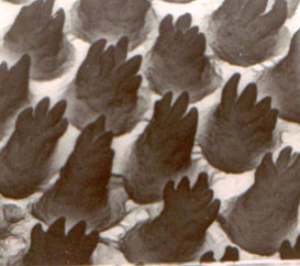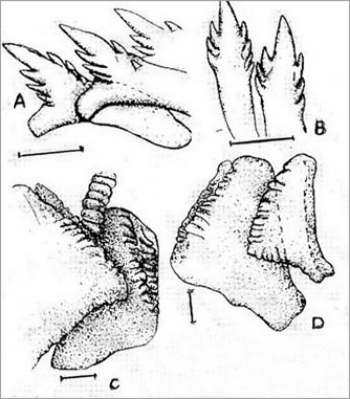Feeding in Scyllaea pelagica
September 10, 2003
From: Irina S. Roginskaya.


FIGURES: Fig.1. SEM photo of the armature of processus masticatorius. x3000
Fig. 2. A,B.Lateral teeth of the radula of S. pelagica. Scale bar =50 microns. C,D - gastric plates of S. pelagica. Scale bar = 100 microns
Dear Bill,
To my regret I never had seen live Scyllaea pelagica and have only had preserved specimens of these species to study(Roginskaya,1987; Iljin and Roginskaya,1987).
My specific aim has been to better understand the mouth structures and stomach contents of these mollusks. The unusual strengthening of the feeding apparatus of S. pelagica by the development of gastric plates - in addition to the multiseriate radula and strong mandibles [jaws] which have powerful chitinous armature of the 'processus masticatorius' (see fig 1: SEM photo of detail) appeared to me rather unjustified, as this species had been considered by many authors to be a hydroid feeder (Marcus,1961; Thompson & Brown,1976,1981; Thompson, 1980). As far back as 1871, Bergh described companularian hydroids in the gut of S. pelagica from the Sargasso Sea.
When we see similar gastric gizzard plates in certain other Dendronotoidea, e.g. in the hind stomach of Marionia, which feeds on hard Alcyonaria, packed with calcareous spicules - this seems quite natural. But what is the advantage of such a complicated alimentary apparatus in S. pelagica which feeds on relatively 'soft' hydroids attached to floating Sargassum weeds?
The material for examination included 25 specimens of S. pelagica - preserved in alcohol - from four sampling sites.
• 1. Seychelles, 10 Dec. 1964; R/V "Vytiaz", cruise 36,sublittoral, depth 1m , one specimen, size 17.0mm.
• 2. Central part of the Gulf of Mexico, 03-05 April 1973; R/V "Akademic Kurchatov" , cruise 14, surface sampling , biocoenosis of floating Sargassum.Two specimens ,size 15.5 and 11.5 mm.
• 3. Sulawesi Sea, near Mindanao Is, 26-27 Febr.1975; R/V "Vytiaz", cruise 57, biocoenosis of floating Sargassum, one specimen,size 10.2mm.
• 4. 33 55'N, 29 16'W, 22 Oct.1981; R/V "Akademic Petrovsky", from the fouling of the bouy, captured in the ocean. 21 specimens, size from 3.2 to 9.0mm.
Unfortunately the stomach of the specimens from the sampling sites no.1 and no.2 proved to be completely empty.The gut contents of the specimen from the sample site no.3 and of five specimens examined from the sample site no.4 [body length: 3.4mm, 4.6mm, 5.3mm, 6.0mm and 9.0mm] were swollen from the accumulation of large bundles of branches of thecate hydroids. (In sample site no.4 - Laomedea dichotoma Vervoort, 1959). And moreover in the stomach of the specimen from sampling site no.3, among the whisks of hydroid branches there was the semi-digested buccal bulb of a juvenile example of the nudibranch Fiona pinnata. Its radular ribbon was in good condition, but the jaw plates were cracked.
The character of the gut contents of these six specimens differed from this of the common littoral hydroid feeders, e.g. the common White Sea Flabellina verrucosa. The food lump in the stomach of Flabellina contains only separate empty hydrothecas in an amorphous substance. I often observed the feeding process of White Sea F. verrucosa on Obelia longissima - how it gravely, methodically, never in a hurry, cuts off from the colony the separate polyps in hydrothecas, leaving the naked hard branches behind. Perhaps this measured behaviour is not suitable in the mobile surrounding of floating weeds, where S. pelagica is forced to hurry engulfing their food object, in case it slips off through wave action? Perhaps that is why it seizes indiscriminately the bundles of hydroid branches, sometimes with small Fiona pinnata as by-catch. The strongly cuticularized folds of the stomach, as well as the well-developed gastric plates most probably represent a modification, functionally connected with the forced swallowing of large hard food fragments. And it is in the hind stomach that the main mechanical cultivation [grinding] of the food is realized. Often fragments of hydroid branches were seen between the gastric plates [see fig.2C]. The discovery of large bundles of thecate hydroid branches in the stomach of several S. pelagica from different geographoc regions [eg: Sulawesi Sea and Atlantic Ocean] indicates that this feeding behaviour is not accidental for this species.
References:
• Bergh,R.1871.Beitrage zur Kenntniss der Mollusken des Sargassomeeres. Verh.d.K.K.Zool. bot.Gesell.Wien.Band 21: 1273-1308.
• Iljin,I.N. & Roginskaya,I.S. 1987. Nudibranchia, Mollusca. In Pelagic epifauna on solid substrates. pp.72-75 In: A.P.Kuznetsov & M.N.Sokolova [eds]. Feeding of marine invertebrates and its significance in the formation of communities. Academy of Sciences of the USSR, P.P.Shirshov Institute of Oceanology, Moscow. [in Russian , with nglish summary].
• Marcus, Ernst. 1961. Opisthobranchia from North Carolina. Journ. Elisha Mitchell Scient. Soc., 77: 141-151.
• Roginskaya, I.S. 1987. Food and feeding of Opisthobranchia: Scyllaea pelagica Linne. pp.43-46/ In: A.P.Kuznetsov & M.N.Sokolova [eds]. Feeding of marine invertebrates and its significance in the formation of communities. Academy of Science of the USSR, P.P. Shirshov Institute of Oceanology, Moscow. [In Russian, with English summary].
• Thompson, T.E. 1980. World species of the Nudibranch family Scyllaeidae. Haliotis, 10(2}: 182.
• Thompson, T.E. & Brown, G.H. 1976. British Opisthobranch Molluscs. Synopses of the British Fauna (New Series). The Linnean Society of London. Academic Press. 203pp.
• Thompson, T.E. & Brown, G.H. 1981. Biology and relationship of the nudibranch mollusc Notobryon wardi in South Africa, with a review of the Scyllaeidae. J. Zool. Soc. Lond.,194: pp.437-444.
Irina S. Roginskaya.
irina7@hotmail.com
Roginskaya.. I.R., 2003 (Sep 10) Feeding in Scyllaea pelagica. [Message in] Sea Slug Forum. Australian Museum, Sydney. Available from http://www.seaslugforum.net/find/10819Dear Irina,
Thanks for these interesting observations on the stomach contents of Scyllaea pelagica. I agree that the remains suggest that this animal is not such a delicate feeder as many aeolids. However since all dendronotoideans have thickened plates or chitinous thickenings in the posterior part of the stomach, then we must assume that this character evolved to meet the needs of the 'common ancestor' to the tritoniids, scyllaeids, bornellids etc. Perhaps they did evolve from an aeolid-like 'proto-bornella' or 'proto-scyllaea' but it seems strange to me that the common ancestor would have had such unique and specialised habits as modern Scyllaea. Most dendronotoideans are benthic feeders on various cnidarians. I would have thought that it was more likely that their common ancestor was also a benthic feeder, and that stomach plates evolved amongst benthic feeders rather than as a reponse to the needs of one pelagic exception. I could of course be quite wrong, so anyone is welcome to join this discussion
Best wishes,
Bill Rudman
Related messages
-
Scyllaea pelagica in Miami
From: Jonathan Cohen, April 9, 2010 -
Sargassum sea slugs in Gulf of Mexico [1]
From: Denice Drass, February 22, 2010 -
Scyllaea pelagica from Nth Carolina
From: John McChesney, June 15, 2005 -
Re: Scyllaea pelagica from Virgin Ids, Caribbean
From: Suzy Hime, May 27, 2005 -
Scyllaea pelagica from Virgin Ids, Caribbean
From: Suzy Hime, May 6, 2005 -
Scyllaea pelagica from Bahamas
From: Marina Poddubetskaia, March 10, 2004 -
Scyllaea pelagica in my aquarium
From: Manuel Marquez, October 17, 2003 -
Scyllaea pelagica new problem
From: Ron Velarde, June 30, 2003 -
Re: Authorship of Scyllaeidae
From: Henk K. Mienis, June 28, 2003 -
Authorship of Scyllaeidae?
From: Gert Lindner, June 21, 2003 -
Feeding in Scyllaea pelagica
From: Jason P. Turner, October 21, 2002 -
Scyllaea pelagica from Turkey
From: Baki Yokes, October 3, 2002 -
Scyllaea pelagica from Brac Island, Adriatic sea
From: Adam Petrusek, October 3, 2002 -
Radula of Scyllaea pelagica
From: Bill Rudman, September 14, 2002 -
Thanks for identifying Scyllaea pelagica
From: Carrie O'Sullivan, June 13, 2002 -
Slug? in Sargasso sea weed
From: Carrie O'Sullivan, June 12, 2002 -
Re: Seaweed creature from Texas
From: Alan Titus , June 3, 2001 -
Seaweed Creature
From: A Titus, June 1, 2001 -
Re: Slug on seaweed
From: Jamin Bortz, May 23, 2000 -
Sea slug/ sea hare in seaweed
From: Jamin Bortz, May 21, 2000 -
Scyllaea pelagica from Florida
From: Anne DuPont, March 9, 2000 -
Hydroids? on Scyllaea pelagica
From: Anne DuPont, March 9, 2000 -
Scyllaea pelagica from Florida
From: Anne DuPont, December 24, 1999 -
More on Scyllaea photos
From: Jim Needham, November 29, 1998 -
Re: Scyllaea photos
From: Jim Needham, November 27, 1998 -
Re: Sargassum sea slug
From: Jim Needham, November 26, 1998 -
Sargassum sea slug
From: Dee Owens, March 21, 1998
